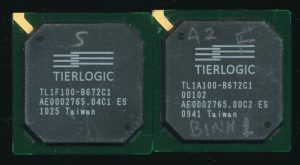Tiered up for 3D-FPGAs: The Story of the Tier Logic FPGA-ASIC
This is the CPU Shack Museum, but occasionally I find a chip thats not really a CPU but is of such interest that I keep it, especially if its novel and relatively unknown. So today we have a bit of the story of Tier Logic. Tier Logic set out to make FPGA (Field Programmable Gate Arrays) better, and to make the transition (or choice) between them and ASICs (Application Specific Integrated Circuit) easier.
FPGA’s are great for smaller product runs, they are configurable, and relatively easy to reprogram, designs can easily be updated/tested with no additional cost. FPGA’s however are large in terms of die area, power budgets, and cost per chip. ASIC’s on the other hand, take longer to develop (re-spinning silicon every time an error is found) and have a much larger upfront cost, as well as an entirely different tool chain to design with. They are however smaller, use less power, and once the design is finalized, the per unit cost is very low. This presents a dilemma in design, which should one choose for a project? What if you didn’t have to choose? What if you could have the flexibility of an FPGA, and the benefits of an ASIC all at once?
It is exactly this that Tier Logic set out to do. Tier Logic was founded by FPGA process-technology pioneer Raminda Madurawe (from Altera) in 2003 and was led by Doug Laird, a founder of Transmeta (famous for the Crusoe VLIW processors). For 7 years they worked to design a solution, working in what is known as ‘stealth mode.’ Stealth mode is a way for companies to work quietly, with little to know PR, until they have a product ready to release. Often the company exists but is completely unknown to outsiders. This has some definite benefits, there is no constant barrage of having to answer/report to the media and others, and their is less risk of someone seeing what you are doing and trying to beat you to market to it. Seven years, however, is a very long time to be in stealth mode, and the reason for this is Tier Logic not only was inventing a new style of FPGA/ASIC, they had to develop a new silicon process to make it work.
Tags:
FPGA
Posted in:
CPU of the Day


